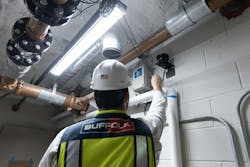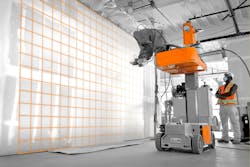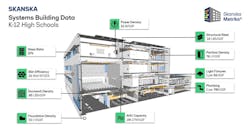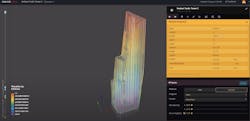Let’s chat about AI: How design and construction firms are using ChatGPT
Tech-savvy AEC firms that already use artificial intelligence to enhance their work view the startling evolution of ChatGPT mostly in a positive light as a potential tool for sharing information and training employees and trade partners.
However, the efficacy of ChatGPT—a conversational-style interface on top of an AI construct known as a large language model that produces on-request narratives—is likely to rest on the construction industry’s aggregation of quality data that, until recently, has been underwhelming for getting the greatest bang from AI and machine learning (ML).
The construction industry’s notorious reluctance to adopt cutting edge tech is seen as both a hindrance and opportunity when it comes to applying AI and Chat to its businesses.
A recent survey of 3,000 global decision makers, conducted for Peak.AI, an artificial intelligence facilitator, found that over the past five years construction ranked lowest among the industries tracked in attempts at digital transformation and success rates for AI projects.
“There are aspects of building production that are yet to be touched by technological advancement,” asserted Senthil Kumar, Chief Technology Officer at the startup Slate.ai, in an interview last year with London-based AEC Magazine. That’s bewildering to him because the “interdependencies of construction’s inherently multi-disciplinary, multi-dimensional, and multi-player ecosystem make [construction] … well suited to modern computational solutions.”
Case in point: In 2019, Coastal Construction, one of Florida’s largest general contractors, helped launch Togal.AI—which uses machine learning to calculate square footage of areas for bidding and takeoffs. In its first year of using this tool, Coastal cut 14,000 hours of work and saved nearly $1 million, “the biggest increase in efficiency for our preconstruction department in 20 years,” says Thomas Murphy, Coastal’s CEO and father to Patrick Murphy, Togal.AI’s Founder and CEO.
EDITORS' NOTE: Is your firm having success utilizing ChatGPT (or other AI chat tools) on your building projects or as part of your business operations?
If so, we want to hear from you! Please email BD+C Senior Editor John Caulfield at [email protected] by Friday, May 5. Please provide as much detail as possible, including any ROI/results analysis. Thanks!
In April, Togal.AI launched its own OpenAI ChatGPT to further assist contractors’ document management. Patrick Murphy tells BD+C that TogalGPT is capable of reading documents in basically all formats, and can search from virtually any relevant document that’s uploaded. He’s hoping the next breakthrough will be the ability to convert images on plans to text. His company is also working with Coastal Construction to launch CodeComply.AI to automatically scan plans to ensure compliance with building codes, and expedite approvals.
AI strategies still undefined for some firms
The refinement of Chat’s ability to generate content that is increasingly indistinguishable from what humans produce has AEC firms scrambling to figure out where Chat fits into their businesses. For example, Bjarke Ingels Group has created BIM AI HUB, an online library for future-ready tools, many of which are powered by AI. But the firm declined to be interviewed for this article, explained Stjepan Mikulić, BIG’s Project BIM Lead, because it had yet to articulate its strategy for using AI and Chat, at least not for public consumption.
DPR Construction’s data team is “trying to understand Chat’s value proposition for construction,” says Tim Gaylord, the firm’s corporate Director of Innovation. To that end, DPR has already conducted what Gaylord amusingly calls “fireside Chats” to discuss this technology with its associates. He’s already anticipating the combination of AI and robotics (for which DPR has a dedicated team) that Gaylord thinks could impact jobsite safety and shortening critical paths in project management.
Five years ago, HOK started experimenting with machine learning to better understand its project data. It leverages AI-enhanced tools like Togal.AI and VueOps. More recently, HOK has been putting the infrastructure in place to use existing data to train ChatGPT. “The industry’s biggest problem right now is keeping records of why a decision was made about a design or a product,” observes Greg Schleusner, AIA, Director of Design Technology for HOK. He adds that HOK’s marketing department is already using ChatGPT for some content. “We’re still feeling our way through with AI, and we haven’t found the killer app.”
Schleusner didn’t sound too impressed yet with deep-learning text-to-image programs—such as DALL-E 2, Midjourney, Revel.AI, Truepic, Firefly, and Stable Diffusion—being much of an improvement over existing generative design models. “It’s too ‘black box’ to think of design that narrowly,” he says of these programs. However, he and other AEC sources agree that AI-generated image optimization is exponentially faster.
Since its inception, Arup has incorporated computational design into its practice. For example, Arup uses computation to optimize the shape and layout of facades “by playing with more variables,” says Kermin Chok, a structural engineer and Associate Principal with the firm. He explains that, as with any technology, the question always comes down to “can we do this at scale?” The answer is Yes: Arup used computational techniques to determine which base isolators would work best for a 1-million-sm hospital in Turkey, which opened in May 2020 with 2,068 isolators.
Chok notes, however, that the datasets needed to train AI models aren’t always available in the construction sector. Consequently, Arup has leaned on simulated data “that we know is correct,” he says, but is also limited to the finite parameters of the test or project from which the data is gleaned.
For the past five or six years, Skanska USA’s data solutions team has focused on building its infrastructure and data warehouse. The firm’s first application was Skanska Metriks, a benchmarking tool that harvests around 400 specific and quantified attributes of projects that Skanska has built. As of March 2023, Skanska had over 300 projects from the past 10 years in this database, says Will Senner, the firm’s Vice President of Preconstruction.
Last year, Skanska layered an AI neural network onto Metriks, with the aim of determining how cost and non-cost factors—like how much concrete or glass is being used in a project—interact. Senner says this data-informed approach allows for a quicker understanding of a project’s “what ifs.” Skanska has tested this new tool against the projects in its database for accuracy. It’s finetuning some variables before it unleashes the tool on a new project. The firm has also held workshops with employees in 20 departments, and is evaluating ideas from those exercises to determine which offers the greatest speed to value.
So far, Skanska has only played around with ChatGPT, and Senner is already “excited” about the prospect of bringing large language models into knowledge sharing of proprietary documents.
A clean data lake for AI and ChatGPT
About five or six years ago, Suffolk Construction started investing in data as a prelude to applying AI to its business. It first found AI to be useful for tracking jobsite safety and why accidents happen. (One discovery: safety, for better or worse, follows the superintendent’s leadership.) Suffolk also developed in-house generative design solutions to support its “X=30” concept that a building could be designed in 30 days. “But we needed some form of intelligence to drive this solution,” recalls John Fish, Suffolk’s Chairman and CEO. And over the years, Suffolk has spent upwards of $50 million to come up with what Fish calls “a clean data lake.” Suffolk currently has 25 data analysts.
Two years ago, the firm formed Suffolk Design, with 25 architects who use AI, and specifically ChatGPT, to take schematics to a more refined level so that buildings can be designed “more coherently,” says Fish.
Another of the firm’s departments, Suffolk Technologies, identifies potentially useful software that support the company’s construction projects. Among these is FIRMUS, a machine learning tool that validates the accuracy of drawings. Fish also points to WINT, a “water intelligence” platform that uses AI to detect and stop leaks during and post construction. Suffolk requires that WINT be included on all projects for which Suffolk holds the builder’s permit. Suffolk is also invested in Airworks, which marries AI and drone technology to tag projects with topographical information.
Fish is confident that, over the next 12 to 24 months, there will be an industry breakthrough in AI because of greater cooperation among firms. The biggest challenge will be getting employees comfortable with AI and not afraid to make mistakes.
He also makes the intriguing prediction that AI will be the vehicle through which blockchain becomes more relevant to the AEC industry by allowing firms to use intelligent design to purchase materials on a global scale without going through middlemen. “AI is going to open the aperture of global procurement,” he says.
Vetting software for synchronicity
Back in 2018, the builder Mortenson, in partnership with ALICE Technologies, was using AI for construction scheduling. That partnership fell by the wayside because, at the time, “it got too hard to implement,” recalls Gene Hodge, Mortenson’s Vice President of i4 and Innovation, whom BD+C interviewed with David Grosshuesch, the firm’s Manager of data analytics and insights.
As it moves forward on its technological journey, finding platforms and software that can be integrated smoothly into Mortenson’s app suite will be “a big deal,” says Hodge. But where AI is concerned, that integration can still be problematic.
Right now, Mortenson is using AI for generating options that can reduce a project’s design to 1-3 days, from 3-6 weeks. It is also using AI in a safety model that analyzes different work outputs on higher-rise projects. “For that, you need a lot of data,” says Hodge, and Mortenson has been favoring systems that capture information better.
Mortenson is already using ChatGPT for marketing and communications. Five years from now, Hodge thinks advancements in AI technology will provide his company with a better understanding earlier about why a project is or isn’t going well. Grosshuesch adds that Mortenson will eventually be able to identify issues sooner by using historical information better. “This would mean that our data landscape is improving,” he says.
Getting to that point will require training. “It’s similar to VDC, and finding the right people,” says Hodge. Given that some of Mortenson’s employees have been exposed to tools like Python—the go-to language for software developers—the transition to ChatGPT shouldn’t be that cumbersome, says Grosshuesch.
Wikipedia on steroids
The March 14 release of ChatGPT-4 incited a media frenzy that raised anxious questions about whether AI was evolving faster than society can cope with.
On one side of the debate are AI advocates and providers like Anar Mammodov, tech founder of Senpex Technologies, a “last mile” logistics platform that uses AI to help industrial distribution centers to optimize route planning and scheduling. His firm has begun exploring ChatGPT for communicating and receiving feedback from clients. And he anticipates that AI will eventually simplify and combine systems that are currently integrated via API systems.
“We expect to see AI impact General Contractors and subcontractors sooner rather than later,” says Ro Bhatia, CEO of PlanHub, the bid management app. “AI will speed data analysis and help project teams make faster, better decisions with a greater degree of certainty.” Bhatia believes that chatbots’ utility will expand “pretty quickly” and include assisting with planning, scheduling and other daily duties. However, he also thinks the industry needs to improve the way it is mining data, via collating and analysis that maximize usability and efficiency.
In the other side of this debate are the skeptics, some of whom speak of AI and Chat in existential and even apocalyptic terms. Earlier this year, on the website futureoflife.org, an open letter with (as of April 24) nearly 27,600 signatories—including Elon Musk, one-time presidential candidate Andrew Yang, and Apple co-founder and tech entrepreneur Steve Wozniak—called upon AI labs to pause their training of systems more powerful that ChatGPT-4, to give society “a chance to adapt.”
AEC firms sound cautiously optimistic about ChatGPT, and less concerned that it will replace humans or be used fraudulently. “As an engineering company, we already have built-in project objectives and constraints” that keep technology outcomes within practical and useful parameters, says Arup’s Chok.
“AI can be scary for a lot of people” worried about losing their jobs, concedes DPR’s Gaylord. But his firm still views technologies like AI and robotics as augmenting, not replacing, workers, and possibly prolonging some of their careers. Where Gaylord is skeptical, until proven otherwise, is about AI’s reliability, and whether it can be trusted to be fully autonomous
“AI measurements are, at best, a first pass,” observes Robert Otani, Chief Technology Officer for the engineering firm Thornton Tomasetti, one of the AEC industry’s more active AI users. He elaborates that the drawback of machine learning is “if it’s not done correctly, [the results] could be wrong, and you need a certain confidence level as engineers.”
Thornton Tomasetti has been pursuing AI solutions since 2015, when it produced a paper showing how a building could be designed with reasonable accuracy in one or two minutes. The firm created a database to come up with a solution for calculating embodied carbon, and then refined that algorithm to calculate structural sizing. After two years of work, the firm produced an app called Asterisk that uses AI/ML technology to design an entire steel or concrete structure. The software uploads core and shell data and can split the buildings virtually into columns and slabs to calculate cost and energy per square foot.
In 2018, Thornton Tomasetti formalized its Core.AI team, and around the same time conducted an R&D project that was trained to expose structural damage during construction. Called T2D2 (for Thornton Tomasetti Damage Detection), this is now a SaaS platform whose latest version was released on April 13, 2023.
Otani also demonstrated an ML-based program called Truss Designer, which simulates a truss span that can be resized in seconds. A similar program measures embodied carbon in floors, beams, footings, concrete, braced forms, and so forth.
Otani thinks AI and ML are “very applicable” for certain early stages of design, primarily optimization of choices. He also thinks this technology can become a valuable training tool.
Thornton Tomasetti has been retraining its AI tools, and training its people to use them. Otani sees value in Chat because “its language platform is better” than humans’. And he foresees a time when Chat will be able to synthesize the collective knowledge of the firm and beyond, and to field questions “that people may have already asked and answered.”




